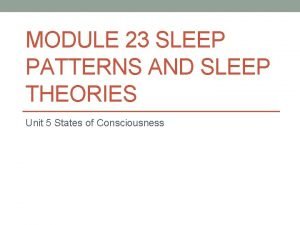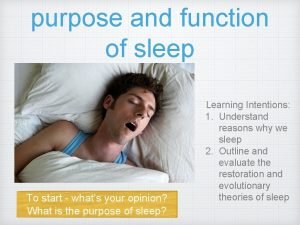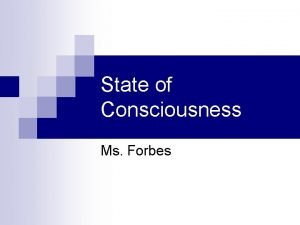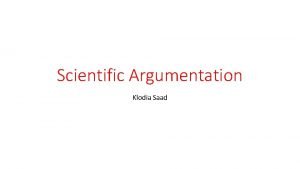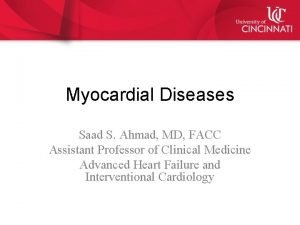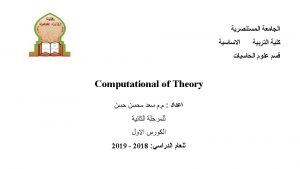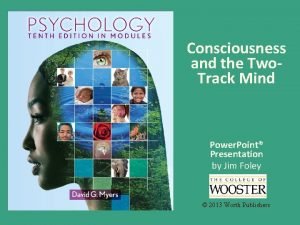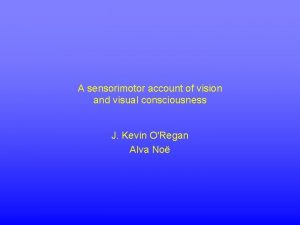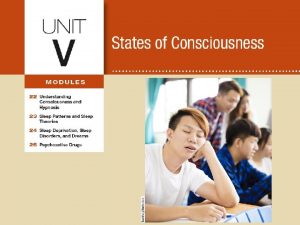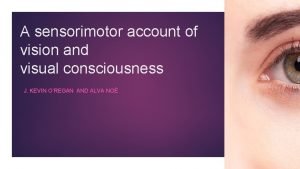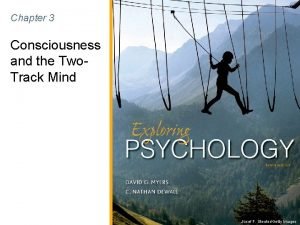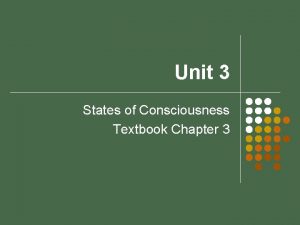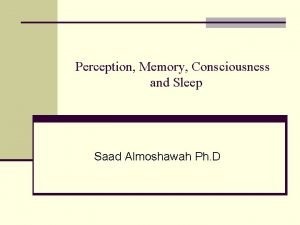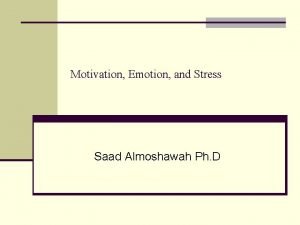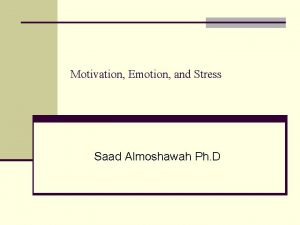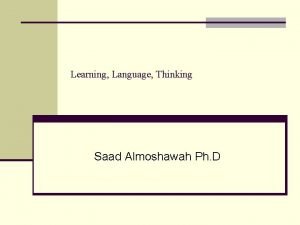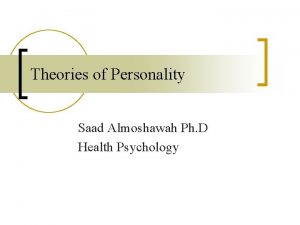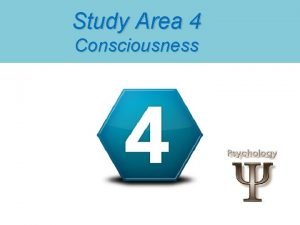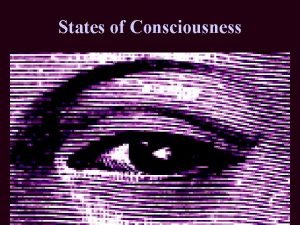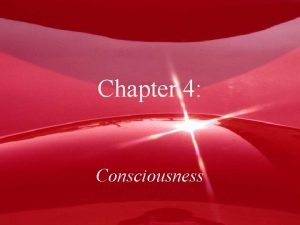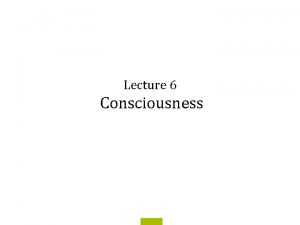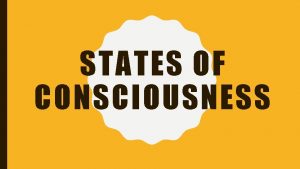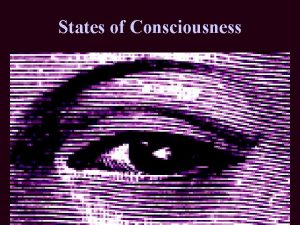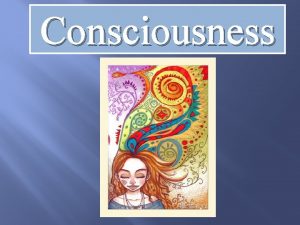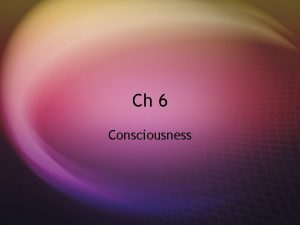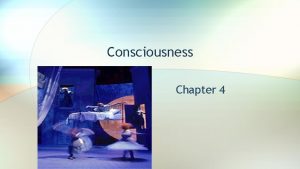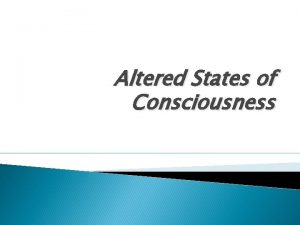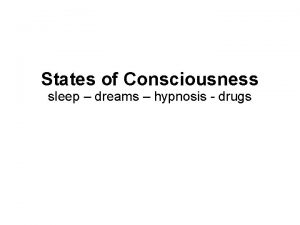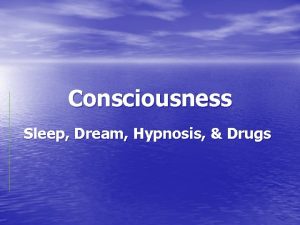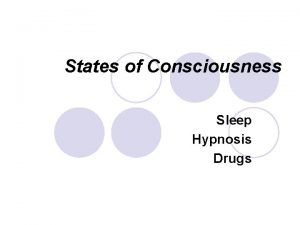Perception Memory Consciousness and Sleep Saad Almoshawah Ph






































- Slides: 38

Perception, Memory, Consciousness and Sleep Saad Almoshawah Ph. D

Perception n Perception is all about how we interpret the information that we receive through the sense organs of the body. n Information which is received directly from the sense organs is known as sensation. It is the actual sensory impressions that we experience. n But if we are to make any sense out of our sensory experiences, if they are to be something more than a tumbled blur of colour, sound, or smells, then we need to interpret them.

Perception n In visual perception (vision is the sense that psychologists have studied in most depth) we need to be able to distinguish objects from their backgrounds; we need to be able to tell whether one object is further away than another one; we need to be able to recognise familiar patterns and faces, and so on. The psychological study of perception consists of investigations of how we go about this, and theories which psychologists have developed to explain it. n Attention is not the same as perception, but it is very closely linked to it.

Perceiving objects and backgrounds n The first step in interpreting sensory information is to organise it. n Perceptual organisation involves converting our impressions of light, dark and colour into meaningful units which can represent the world around us. n The first step in this process is to be able to distinguish objects and figures from backgrounds. The way that we do this has been studied by psychologists for many decades. n Distinguishing figures from backgrounds is very basic to perception. It is so basic, in fact, that we will try to do it even if the figures are not 'really' there. If we are faced with a mass of confusing sensory information, we try to group together different stimuli so that we can detect patterns.

The Gestalt laws of perception n During the 1930 s, the Gestalt psychologists investigated how we go about perceiving objects and figures. They identified a set of principles of perception, which they referred to as the laws of Pragnanz has the same linguistic origin as our word 'pregnant', and it means 'loaded with meaning'. n The Gestalt laws of Pragnanz show we attribute meaning of some sort even to the most simple collections of visual stimuli. There are four of them altogether.

n The first is the principle of similarity. According to this principle, if we look at a set of stimuli, and if none of the other Gestalt laws apply, then we will automatically group similar ones together. n But this is easily overtaken by the second principle: the principle of proximity. According to this principle, stimuli which are close to each other will be seen as forming a group, even if they are not particularly similar

n The third, and perhaps the strongest of the Gestalt principles of perception, is known as the principle of closure. Broadly speaking, it is that we have a strong tendency to prefer closed figures rather than fragmented or unconnected lines. This principle is so strong that it can override all of the others. n And the fourth Gestalt law is the principle of good Gestalt. This affects our perception, in the form of a preference for figures which appear to be well rounded or symmetrical, rather than ones that seem fragmented or messy.

Face recognition n One area of research which forms an interesting link between top-down and bottom-up theories of perception is the study of how we go about recognising faces. n Recognising people from their faces is something that we do quite automatically, yet when researchers analyse it, they find that it actually involves a number of very complex tasks. For instance, we can recognise the same person several years later, when their facial features have become changed with age; and we have no difficulty in recognizing the same face even though it may be showing wildly different emotional expressions

Face recognition n In general terms, it seems that we rely more on features from the upper part of the face, like hair or eyes n When we are recognising faces that are familiar to us, we seem to use a combination of descriptive cues. Some of these are about the particular features of the face itself, such as the colour of the eyes or the shape of the mouth, while others are about the spacing between the different features.

Face recognition n Ellis, Shepherd and Davies (1979) found that when we are recognising familiar faces, we tend to concentrate more on the internal features of a face, like eyes, nose and mouth. n When we are recognising unfamiliar faces, though, we concentrate more on external features like hair and chin. In fact, it seems as though we recognise familiar and unfamiliar faces in completely different ways, involving different cognitive mechanisms.

Face recognition units n Bruce and Young (1986) explored the implications of this, and other evidence, and suggested that we develop a face recognition unit for identifying people that we know. n Faces of strangers do not have recognition units, and so when we are recognising those, we have to fall back on descriptive criteria, such as hair colour, to know whether we have seen that face (or a picture of it) before. n This could also explain why we do not usually notice facial resemblances between our friends, although we often notice strangers who look like people that we know.

Face recognition units n We have a special recognition unit for each friend, so their faces only stimulate their own unit. But the faces of strangers can trigger off other recognition units because they do not have one of their own. n Recognising faces and remembering names n A face recognition unit of this kind includes deeper knowledge about that person, and perhaps also our own feelings about them, such as whether we liked or disliked them. This is semantic information - in other words, it is meaningful information about how the stimulus actually affects us.

Memory n We use memory all the time, in everyday living as well as when we are studying. Think of the last time that you decided to travel, try to remember every single moment n Memory research has a long and important history within psychology. One of the first researchers into memory was the introspectionist psychologist Herman Ebbinghaus (1885) who established a tradition of meticulous work in studying psychology as an experimental topic in the laboratory. His work established a methodology and approach which was highly influential in memory research right through to the 1970 s.

Memory n from 1932 onwards, a different tradition in memory research also emerged, originating with the work of Sir Frederick Bartlett studied how people make sense of the information that they receive, and how their personal values and ideas affect what they remember. n This approach to 'real-life' memory also had its impact, eventually leading to a new emphasis on research into everyday memory in recent years.

The Three Processes in Memory: Encoding. Storage, and Retrieval n What three processes are involved in the act of remembering? n What must occur to enable us to remember a friend's name, a fact from history, or an incident from our past? The act of remembering requires the successful completion of three processes: encoding, storage, and retrieval. n The first process, encoding, involves transforming information into a form that can be stored in memory. Sometimes we encode information automatically, without any effort, but often we must do something with the information in order to remember it

The Three Processes in Memory: Encoding. Storage, and Retrieval n For example, if you met someone named Omer at school, you might associate his name with your brother or best pal. Such simple associations, as you will see, can markedly improve your ability to recall names and other information. The careful encoding of information greatly increases the chance that you will remember it. n The second process in memory, storage, involves keeping or maintaining information in memory. In order for the encoded information to be stored, some physiological change in the brain must take place a process called consolidation.

The Three Processes in Memory: Encoding. Storage, and Retrieval n Consolidation occurs automatically under normal circumstances, but if a person loses consciousness for any reason, the process can be disrupted and a permanent memory will not form (Deutsch & Deutsch, 1966). That is why it is not unusual for a person who has been in a serious car accident to awaken in a hospital and not remember what has happened.

The Three Processes in Memory: Encoding. Storage, and Retrieval n The final process, retrieval, occurs when information stored in memory is brought to mind. Calling Omer by name the next time you meet him shows that you have retrieved his name from memory. To remember, we must perform all three of these processes encode the information, store it, and then retrieve it. n Memory failure can result from the failure of any one of the three processes

Memory storage n Once the information has been encoded, it needs to be stored. A number of different explanations have been put forward to explain how this happens, and how memory is structured. n The first is the two-process theory of memory, which is also sometimes called the structural model of memory (short-term memory STM and long term memory. LTM). n The second was put forward as a challenge to the structural model, and is known as the levels of processing approach. n The third is the working memory model which provides an alternative to the idea of short-term memory storage.

Theories of forgetting n The past hundred years of memory research have seen several psychological explanations forgetting. n Some theories about forgetting have been very specific, concerning the decay of the memory trace; brain damage or disease; motivated forgetting; or interference from other material. n The reasons why we forget are to do with other characteristics of memory. n There is a considerable amount of work, for instance, which shows how important context, cues and processing are for remembering; and so forgetting can sometimes be seen as arising from inadequacy in this respect.

Decay of the memory trace n One of the earliest ideas about memory storage was that each remembered item would leave a kind of physiological memory trace' in the brain, known as an engram. n Unless this engram was strengthened by rehearsal, it would gradually become weaker until it eventually decayed altogether through lack of use. Recalling or recognising the item again would 'refresh' the engram. So memories which were not used would die away, and those which were called to mind frequently would be strong.

n This theory of forgetting is a plausible one, which fits with our subjective experience. But, in fact, it is almost impossible to test it out - we cannot possibly know if a memory exists unless we try to use it, and the act of doing that would presumably strengthen the engram. We also have the problem of constructive memory: as we will see, a person who is trying to remember something can unconsciously produce a plausible reconstruction, instead of a 'real' memory, and we would not be able to tell the difference.

Brain damage or disease n There are several different ways that amnesia can happen, ranging from brain damage or head injuries to problems arising through ageing. n It is also difficult to be sure that a problem really is some form of amnesia. n Talland (1968) showed how most people have failures of memory in normal life, so it is important not to confuse normal forgetting with a memory disorder.

Brain damage or disease n Post-traumatic amnesia is the kind of amnesia which follows a severe blow or wound to the head. This can often result in the loss of memory for the few minutes leading up to the accident. n Being unable to remember things that have happened in the past is known as retrograde amnesia. n anterograde amnesia, this is where the individual is unable to store new memories, even though they may retain their memories from before the damage was done.

Brain damage or disease n Milner (1966) described a patient, H. M. , who experienced anterograde amnesia as a result of brain surgery in which both sides of the hippocampus were removed. After the operation, H. M. found himself to be unable to retain new information, although he could still remember things that he knew before. n Korsakoff's syndrome is one of the most common sources of anterograde amnesia. It develops in long-term alcoholics, who have been drinking heavily and not eating well for many years. This produces a thiamine deficiency which eventually results in the person becoming unable to store new memories.

Brain damage or disease n People with Korsakoff's syndrome often become highly skilled at maintaining conversations by making general remarks; so it is often difficult to realise how badly their memory is damaged. n But sometimes it is so severe that the person cannot recall someone that they have met only that morning, if they meet them later in the same day.

Consciousness n One of the distinctive features of human beings, so it is claimed, is that we are aware of our own consciousness. But trying to identify and classify consciousness is not easy. n We are continually experiencing changes in consciousness. we have all experienced how different moods can affect how we see the world. n we have all experienced the changes in consciousness brought about when we are sleeping; and most of us have experienced the changes in consciousness brought about by at least some drugs, if only the use of caffeine to help us wake up in the morning. In many ways.

Consciousness n consciousness is one of the most mystical of all human attributes or at least, there has been a great deal of mystical writing about it. n In the early days of psychology, consciousness was regarded as the core of the discipline. n The introspectionist psychologists regarded the study of the mind as the key to understanding everything about people, and they believed that the careful analysis of conscious experience would allow them to discover the workings of the mind.

Consciousness n consciousness idea was challenged by a number of theoretical developments, and in particular the two opposing ideas of psychoanalysis and behaviourism. n The Freudian idea that much of the mind's operation is unconscious, taking place without the individual being aware of it, questioned the idea that the contents of consciousness can be reached by introspection; and the behaviourist insistence that human behaviour could be seen as the result of stimulus-response conditioning questioned the importance of the concept of consciousness in an even more fundamental way.

Consciousness n In more recent times, psychologists have grown away from the behaviourist's total rejection of the idea of consciousness, and there have been a number of attempts to investigate it. n Consciousness appears to serve an important function in allowing us to choose our actions. By weighing up a situation we can select what we would like to do. n Consciousness also helps us to change or modify our behaviour, if we find that we are acting inappropriately. But identifying what it actually is, presents us with considerable challenges.

Psychoactive drugs and consciousness n Psychoactive drugs are drugs which affect an individual's mental state: they may directly change our moods or how we respond to the environment. n In general, psychoactive drugs produce their effects because they affect the way that neurones communicate with one another at the synapse. n Sedatives and depressants n The most commonly used sedative drug is undoubtedly the drug alcohol. Like caffeine, alcohol is a very powerful drug which we often overlook because it is in everyday use.

Psychoactive drugs and consciousness n Many people, for instance, believe that they can drive adequately even when under the influence of the drug, although when they are tested on a driving course even very small amounts of alcohol result in many misjudgements. n The widely used recreational drug marijuana is also a depressant drug, which slows reaction time and induces drowsiness. It was used as a tranquilliser during the nineteenth century, and for over two thousand years in China and on the Indian subcontinent, although owing to the development of more specific drugs, it is no longer used medically in the Western world.

Sleep n Part of the study of consciousness includes the study of sleep and dreaming. Sleep raises a number of questions. n What is going on when we are asleep? Why do our bodies need to have these regular periods when normal everyday behaviour seems to be turned off, and we remain quiescent for hours on end? What happens when we do not get enough sleep? And why do we dream? n Researchers have been investigating the phenomenon of sleep throughout the second half of this century, looking at the physiology of sleep, and at sleep cycles, at how it is controlled by the brain, and at what happens when we dream

Rhythms of sleep n As well as being part of our behavioural circadian rhythms, sleep has its own internal rhythms. n We are aware of some of the general changes which happen when we sleep. n The muscles become flaccid, the 'attention-monitoring' systems of the brain seem to shut down, and we experience a lengthy period of passivity and inaction. But that is not all that is going on.

n Dement and Kleitman also showed that, during the course of the night, we pass through the different levels of sleep several times, moving from higher to lower levels of sleep, and back to higher levels again. n They argued that this cycle is repeated several times during a typical night, although the deeper levels of sleep tend to be reached only during the first few cycles. n Towards the end of the night, sleep cycles become shallower, which Dement and Kleitman interpreted as the person being more liable to wake up. Their conclusion, then, was that the changes in EEG pattern reflected how deeply the person was asleep.

Sleep-deprivation studies n People can do without sleep for very long periods of time, and often manage surprisingly well on most tests of psychological and physical functioning. n But this does not mean that sleep deprivation has no effect: there are other, more general, consequences which seem to result. n One of the problems seems to be that people who are seriously sleep deprived can often rouse themselves successfully for short-term tasks, but find themselves losing awareness when undertaking routine or repetitive activities. n They are able to do the kinds of controlled tasks which provide experimenters with precise measurements, like reaction time exercises or decision-making simulations

Sleep disorders n There a number of abnormalities of sleep, which can result in considerable discomfort for someone who is experiencing them. n Perhaps the best known of these is the sleep disorder known as insomnia, in which people experience difficulty getting to sleep or remaining asleep. n Insomnia can arise for many reasons, but is frequently associated with physiological states of anxiety and tension.

Dreaming n Everybody dreams during the course of the night, although some people claim that they never do. This seems to be because they have no recollection of having dreamed when they wake up. n Dreams, as we know, are fascinating things, and explaining dreaming has been a major preoccupation of human cultures for as far back as we can possibly know. n Saudi Culture of dreaming, did we believe in dream? n Open issue of dream.
 Types of social mobility
Types of social mobility Module 16 sleep patterns and sleep theories
Module 16 sleep patterns and sleep theories Module 23 sleep patterns and sleep theories
Module 23 sleep patterns and sleep theories Module 23 sleep patterns and sleep theories
Module 23 sleep patterns and sleep theories For sidney sleep is livelier than reality because
For sidney sleep is livelier than reality because Adults spend about ______% of their sleep in rem sleep.
Adults spend about ______% of their sleep in rem sleep. Klodia saad
Klodia saad Saad ahmed javed
Saad ahmed javed Saad ahmed javed
Saad ahmed javed Dr sadia saad
Dr sadia saad Tidal energy assignment
Tidal energy assignment Saad ahmad md
Saad ahmad md Movie database
Movie database Télégestion saad
Télégestion saad Saad ahmed javed
Saad ahmed javed Joanne saad
Joanne saad Saad mohsen ٨- احذر احذر
Saad mohsen ٨- احذر احذر Saad azhar saeed ucp
Saad azhar saeed ucp Dr hussein saad
Dr hussein saad Saad alshahrani
Saad alshahrani Avp 3
Avp 3 Internal memory and external memory
Internal memory and external memory Primary memory and secondary memory
Primary memory and secondary memory Page fault
Page fault Semantic memory example
Semantic memory example Implicit memory vs explicit memory
Implicit memory vs explicit memory Long term memory vs short term memory
Long term memory vs short term memory Logical memory is broken into
Logical memory is broken into Which memory is the actual working memory?
Which memory is the actual working memory? Virtual memory in memory hierarchy consists of
Virtual memory in memory hierarchy consists of Eidetic memory vs iconic memory
Eidetic memory vs iconic memory Shared memory vs distributed memory
Shared memory vs distributed memory Two-track mind
Two-track mind A sensorimotor account of vision and visual consciousness
A sensorimotor account of vision and visual consciousness Module 22 understanding consciousness and hypnosis
Module 22 understanding consciousness and hypnosis A sensorimotor account of vision and visual consciousness
A sensorimotor account of vision and visual consciousness Chapter 3 consciousness and the two-track mind
Chapter 3 consciousness and the two-track mind Stream of consciousness literature
Stream of consciousness literature 3 states of consciousness
3 states of consciousness

